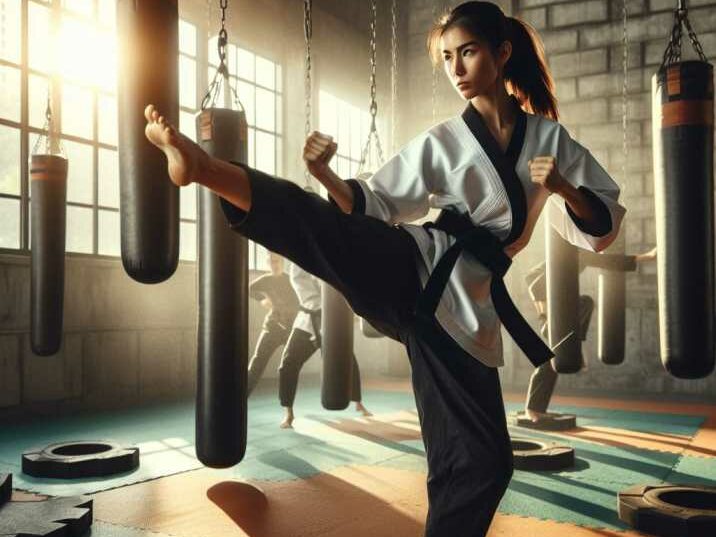Obstacle Course Drills for Elevating Kicking Techniques
Table of Contents
Introduction:
In the world of martial arts and sports, the mastery of kicking techniques is an intricate dance between precision, power, and agility. While traditional training methods have long been the cornerstone of skill development, the integration of obstacle course drills introduces a dynamic and unconventional approach. This article serves as your comprehensive guide to “Obstacle Course Drills for Improving Kicking Techniques,” exploring ten unique exercises designed to push the boundaries of your kicking proficiency.
The Essence of Obstacle Course Drills:
Understanding the Impact
Before we dive into the specifics of the drills, let’s grasp the significance of obstacle course training in refining kicking techniques. These drills are not just about overcoming physical barriers but also about sharpening focus, balance, and adaptability – essential components of a formidable kicker.
The Science Behind it
To truly appreciate the benefits, it’s crucial to understand the science behind obstacle course drills. From improved neuromuscular coordination to heightened proprioception, these drills offer a holistic approach to enhancing the mind-body connection, a critical aspect of mastering complex kicking movements.
The 10 Obstacle Course Drills:
Precision Pylons
Precision is the cornerstone of effective kicking. Arrange pylons in a specific pattern, challenging the kicker to navigate with precision, thereby enhancing spatial awareness and control.

Hurdle Hurdles
Adaptability is key in any combat sport. Incorporate hurdles at varying heights, forcing the kicker to adjust kicking techniques dynamically for optimal clearance, fostering agility and flexibility.
Tire Tactility
Accuracy is honed through tactile experiences. Kick through suspended tires, enhancing targeting precision while navigating through a dynamic space, simulating real-world scenarios.
Platform Precision
Balance is the unsung hero of kicking proficiency. Practice on elevated platforms, introducing an element of instability that improves core strength and kicking control.
Speed Ladder Challenge
Footwork is the foundation of kicking. Integrate a speed ladder into kicking drills, focusing on footwork, agility, and rapid-fire kicking sequences, elevating the overall skill set.
Reactive Targets
Combat situations demand quick decision-making. Employ targets that react to kicks, fostering the ability to adapt kicking techniques in real-time, enhancing mental acuity.
Blindfolded Mastery
Muscle memory is a kicker’s best friend. Kick with a blindfold, emphasizing reliance on muscle memory, enhancing proprioception, and refining spatial awareness.

Water Balloon Precision
Unpredictability is a true test of skill. Kick water balloons suspended at varying heights, refining accuracy and introducing an element of unpredictability to the training regimen.
Maze of Balance
Balance is the unsung hero of kicking proficiency. Navigate through a maze-like structure, improving balance, coordination, and kicking precision in diverse environments.
Unpredictable Obstacles
Real-world scenarios are unpredictable. Incorporate random obstacles that appear during kicking drills, simulating combat situations and enhancing adaptability.

Conclusion:
In the pursuit of mastering kicking techniques, incorporating obstacle course drills proves to be a game-changer. The diverse range of exercises outlined here challenges practitioners mentally and physically, fostering a well-rounded skill set that transcends traditional training boundaries. Elevate your kicking prowess by embracing these dynamic drills and witness a transformation in your performance on the mat or field.
FAQs:
- Q: How often should I incorporate obstacle course drills into my training? A: Depending on your current fitness level, aim for 2-3 sessions per week to gradually integrate these drills into your routine.
- Q: Can beginners benefit from these drills? A: Absolutely! Start with simpler drills and progressively increase the complexity as your skills improve.
- Q: Are these drills suitable for all martial arts disciplines? A: Yes, these drills are adaptable and beneficial for various martial arts disciplines that involve kicking techniques.
- Q: Do I need special equipment for these drills? A: Minimal equipment is required, such as pylons, hurdles, and a speed ladder. Most drills can be modified with household items.
- Q: How do obstacle course drills improve kicking accuracy? A: By introducing dynamic and unpredictable elements, these drills enhance spatial awareness, precision, and adaptability in kicking movements.
- Q: Can I create my obstacle course at home? A: Absolutely. Many of these drills can be adapted for home use, utilizing common household items as substitutes for traditional equipment.
- Q: Is there a recommended warm-up before engaging in these drills? A: Yes, a thorough warm-up is crucial to prevent injuries. Include dynamic stretches and light cardio to prepare your muscles.
- Q: Are these drills suitable for children? A: Yes, with appropriate supervision and modification of difficulty levels, these drills can be engaging and beneficial for young practitioners.
- Q: How do blindfolded drills enhance kicking skills? A: By eliminating visual cues, blindfolded drills force reliance on muscle memory, proprioception, and spatial awareness, refining kicking techniques.
- Q: Can these drills be incorporated into group training sessions? A: Absolutely. Many of these drills can be adapted for group training, fostering camaraderie and friendly competition among participants.
- Q: Will these drills improve my overall athletic performance? A: Yes, the agility, balance, and coordination developed through these drills have a positive impact on overall athletic performance.
- Q: How long should each obstacle course session last? A: Aim for 30-45 minutes per session, allowing sufficient time for warm-up, drills, and cooldown to maximize effectiveness.


